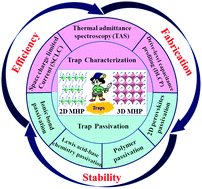Traps in metal halide perovskites: characterization and passivation
Abstract
Metal halide perovskites (MHPs) have become a research focus in the field of optoelectronics due to their excellent optoelectronic properties and simple and cost-effective thin film manufacturing processes. In particular, the power conversion efficiency (PCE) of solar cells (SCs) and external quantum efficiency (EQE) of light-emitting diodes (LEDs) based on perovskite materials have reached 25.2% and 21.6%, respectively, in a short period, making perovskites especially promising for fabricating next-generation optoelectronic devices. Despite these inspiring results, obtaining high-performance, high-stability MHP-based devices still faces many challenges, among which the defects and the consequent traps in MHPs are key factors. Defect-induced traps can trap charge carriers or even act as non-radiative recombination centers, seriously degrading the device performance, causing hysteresis and deteriorating the stability of MHP-based devices. Thus, understanding the chemical/physical nature of traps and adopting appropriate strategies to passivate traps are important to enhance the device performance and stability. Herein we present a review in which the knowledge and understanding of traps in MHPs are considered and discussed. Moreover, the latest efforts on passivating traps in MHPs for improving device performance are summarized, with the hope of providing guidance to future development of high-performance and high-stability MHP-based devices.

- This article is part of the themed collections: 2020 Nanoscale HOT Article Collection and Recent Review Articles


 Please wait while we load your content...
Please wait while we load your content...